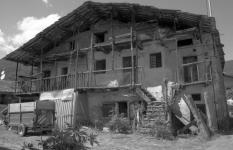Sears, Roebuck and Co est un Manufrance à l'américaine.
No. 1. R. W. SEARS, PRESIDENT SEARS, ROEBUCK & CO., AT HIS DESK
Tout d'abord, je tiens à vous inviter cordialement, ainsi que vos amis, à visiter notre institution si jamais vous deviez visiter Chicago ou passer par notre ville.
Je regrette qu'il ne soit pas possible pour moi de rencontrer chacun de nos clients face à face et de les connaître personnellement; Cependant nos relations avec des centaines de milliers, bien que séparées par de nombreux miles, ont été si agréables et satisfaisantes que je sens que je les connais presque comme des voisins, et si nous nous rencontrons, ils seraient presque aussi disposés à me saisir par la main que je leur. .
Je regrette aussi que tous nos clients ne puissent pas voir de leurs propres yeux l'endroit où leurs commandes sont remplies et voir les gens qui font le travail, comment ils le font et comment ils sont dirigés.
Pour le bénéfice de tous ceux qui ne peuvent pas, du moins pour le moment, nous voir et notre institution et à qui nous n'avons pas eu, et peut-être ne pourrions jamais avoir, le plaisir d'étendre la main droite de la bonne camaraderie, me donnant ainsi le grand Plaisir de face à face en vous remerciant pour vos faveurs et votre confiance, ces cinquante vues stéréoscopiques ont été obtenues que vous, dans votre propre maison, peut avoir un peu d'aperçu sur les façons dont nous faisons nos affaires et l'endroit où il est fait . Bien sûr, nous pourrions continuer à faire des centaines de points de vue différents, mais nous espérons que ces cinquante vous donnera une idée générale de notre place.
En espérant que cette vision stéréoscopique dans notre institution vous fera vous sentir encore mieux familiarisé avec Sears, Roebuck & Co., et l'écrivain, je suis, très reconnaissant à vous,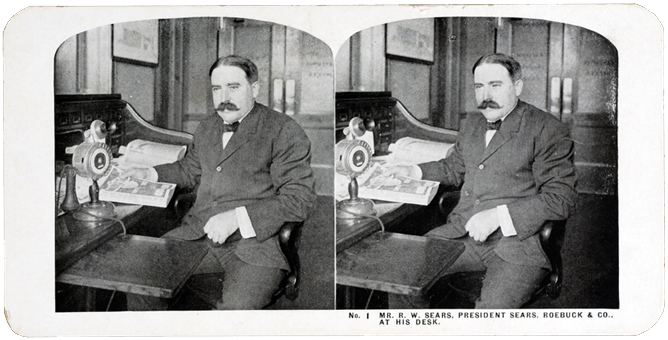
No. 2. GENERAL VIEW
Cette photographie donne une vue générale de la grande institution commerciale Sears, Roebuck & Co, Chicago, 111., lorsqu'on y arrive de l'est par Harvard Street. Le premier édifice à gauche est le grand bâtiment d'impression, avec ses nombreuses presses perfectionnées, ses excellentes reliures et les départements Publicité et Mailing, où nous traitons chaque jour plus d'impression et plus d'envois que n'importe où ailleurs dans le monde. Le deuxième bâtiment est le batiment de l'administration, où la force des correspondiers, exerce son travail quotidien, traite de la correspondance reçue de nos clients. Le grand bâtiment plus loin est le bâtiment des marchandises et dans cette structure se trouvera presque tout ce qui est envisageable; un stock de marchandise évalué à plus de 8 000 000 $. Les dimensions dans cette image sont tellement grandes que l'objectif de l'appareil photo ne montre qu'une partie des grands bâtiments dans lesquels se trouvent plus de cinquante acres d'espace consacré à notre entreprise. Cette photo a été prise le matin juste avant le début des affaires.
These buildings are located in the residence section of the great City of Chicago and they are so large, towering so far above all other buildings in the immediate neighborhood that they may be seen for miles from almost any direction. Many of the railroad lines running in and out of Chicago-pass within five or six miles of this great plant and the buildings may be seen from the car windows. From the observation tower on the Merchandise Building a birdseye view of the whole City of Chicago may be had on a reasonably clear day.

No. 3. MAIN ENTRANCE MERCHANDISE BUILDING.
The illustration in this stereoscopic view showing the main entrance of the great Merchandise Building, gives you a glimpse at a spot where more than 6,000 pairs of feet pass in and out every working day in the year. This is the Tower entrance, and the scene here illustrated is a common one between 7:30 and 8:00 o’clock every morning. Just within the entrance and back of the lobby are a number of passenger elevators which carry our employees and visitors to and from the nine stories of the building proper and the fourteen stories of the tower. The tower is of fireproof construction; granite, terra cotta, brick and steel being used in its erection. The executive offices of many of the managers of merchandise departments are located in the tower, and several of the upper floors are devoted to the educational departments. At the extreme top of the tower is located one of the great water reservoirs, which is a part of our own system of fire protection. Any visitor who has passed through the plant of Sears, Roebuck & Co. will recognize this picture, and we trust will have pleasant recollections of his visit to this greatest merchandising institution in the world, and this largest building in the world devoted to merchandising enterprises.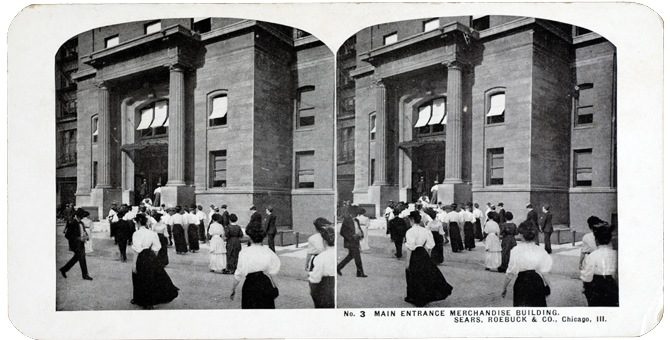
No. 4. THE MERCHANDISE BUILDING.
The Merchandise Building we call the “works” because it is here that the largest army of our employees is busy from early morning until late at night in filling the orders from our customers. This building is the largest ever erected for housing merchandise, being eleven hundred feet long by three hundred and fifty-five feet in width, nine stories high and basement. Within these walls will be found every conceivable sort of merchandise, requiring a catalogue containing twelve hundred pages almost nine by twelve inches in size, together with innumerable special catalogues to properly list, illustrate, describe and price the articles in which we deal, so that the customer may intelligently state his wants. Over eight million dollars’ worth of merchandise is constantly carried in stock, and this enormous business structure with its vast machinery and its perfected organization is the concrete product of the building progress of the world and the sum of human endeavor in providing mechanical equipment and appliances to facilitate the filling of orders and their prompt dispatch by mail, by express and by freight to every quarter of the globe. In a building so large it is not surprising that many unusual problems came up for solution from day to day, but all these difficulties have been solved, and this great structure, this teeming hive of industry, is well lighted, perfectly ventilated, systematically arranged, thoroughly heated, and in every way a model institution.
As a foundation under the walls of the Merchandise Building we have fifteen hundred and six caissons, four feet or more in diameter, and from twenty to sixty feet deep. In building these caissons we used sixty-five thousand cubic yards of concrete. In all the buildings, which are of “brick and terra cotta construction, we consumed twenty-eight million brick, twenty-five thousand barrels of lime, one hundred and thirty thousand barrels of cement, fifteen million feet of lumber and twelve million eight hundred thousand pounds of steel and iron. These colossal figures are almost beyond comprehension, involving as they do such enormous quantities of materials as never before have been used in the construction of a home for any business concern in the world. Perhaps in your own city you have a brick merchandise building, or several of them, forty feet wide, eighty feet deep, two stories high with a basement underneath. Our Merchandise Building alone, which is almost a quarter of a, mile long, a block wide, and nine stories high, is equivalent to three hundred and eight such buildings. Some idea of the quantity of lumber we used in the construction of these buildings may be conveyed when we say that the average forest will produce not more than five thousand feet of hardwood lumber to the acre, and it would require the timber from three thousand acres to yield the quantity of lumber we used in our buildings.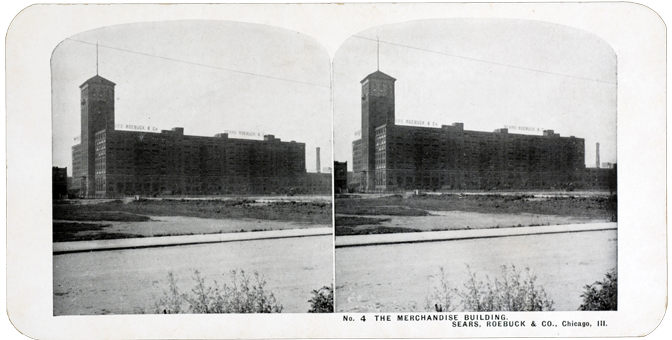
N° 5. Sunken Garden avec au loin, le bâtiment commercial.
Aussi loin que l'objectif photographique détaille cette vue, tout ce que vous voyez est la propriété de Sears, Roebruck & Co. Cette vue a été prise à partir de l'extrémité de Sunken Garden.
Devant vous sont les immenses massifs ornementaux formés de plantes en pots, et juste derrière, le lac avec le jet d'eau jouant dans la lumière du soleil ; sur la droite, la Pergola ; sur la gauche au fond, le grand "Merchandise Building".
Il est regrettable que vous ne puissiez voir cette magnifique vue dans toute sa splendeur, de beauté et de contraste. Nous regrettons qu'il ne nous ait pas été possible de représenter ces scènes, dans nos installations et alentour, par ce merveilleux et nouveau procédé de photographie en couleurs, et nous regrettons surtout que cette vue en particulier ne puisse être reproduite en couleur par ce procédé.
Les endroits aussi brillants et attractifs tels que nos jardins sont rares et lointains pour une grande cité comme Chicago ; et si jamais vous visitez nos installations et que vous soyez là vers midi, quand des milliers de nos employés quittent leurs offices pour déjeuner et passer un moment en plain air, vous réaliserez ce que ces jardins, avec sa richesse d'arbres et d'arbustes, de fleurs et de plantes, représente pour cette masse d'hommes et de femmes, dont beaucoup vivent dans des maisons basses sans aucun jardinet, ni devant ni derrière, sans la moindre touffe d'herbe verte ou une fleur pour rafraîchir l’œil dans aucune direction.
No. 6. THE RAILROAD YARDS.
One of the very first considerations with us in choosing the location for our new merchandise plant was that of locating where, transportation facilities would be unsurpassed, and this picture will give you some idea of why we found it necessary to secure the very best railroad facilities to be had in the City of Chicago. The volume of our shipments by freight, by express and by mail is so great that $10 single railway line would be able to give us adequate service. In locating on the Chicago Terminal Transfer Railway we are brought in touch with every railway line but two which enters the City of Chicago, and the railway companies, appreciating our needs, have certainly given us unexcelled facilities both for receiving and for shipping merchandise. The stereoscopic view herewith is a glance across our railway yards adjoining the premises looking toward the Merchandise Building. On this side of this great structure we receive merchandise only, all shipping being done from the other end of the building. Engines and train crews are busy in these yards night and day handling the cars necessary to the successful prosecution of our business.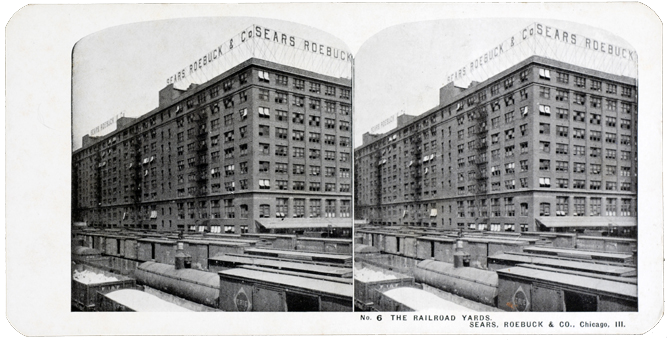
No. 7. AUTOMATIC MACHINES IN THE GROCERY DEPARTMENT
We operate the largest retail grocery store in the world, and we have built up our enormous business by supplying our customers with uniformly highest quality groceries at the lowest possible prices. Our business in food stuffs has grown very rapidly in recent years, and since it has grown to such a large volume, we have found it advantageous to become manufacturers of a great majority of the lines sold by us and in still other lines we have become importers or have arranged with the producers to take their entire product. This has had the effect of largely reducing the cost of the merchandise to us and these large savings we have given to our customers in the form of lower prices. We have employed one of the best chemists to inspect all the food stuffs sold by us, and everything we sell conforms to the highest government standard. In addition to quality, we are very particular that every article which is sold by weight or measure shall be full weight and full measure; and to that end, we have installed in our grocery department the most up to date machinery for automatically weighing and measuring and wrapping all those lines of goods which are sold by weight or measure. The picture on the other side gives you a view of a few of these machines. They are operated by electricity, and they are so carefully adjusted that it is a practical impossibility for them to give a wrong weight or a wrong measure. The great bins overhead are filled with rice, or coffee, or tea, or whatever the product may be that we are putting up that particular day, and the speed of the operator in placing the empty sack and taking away the filled receptacle is the only thing which places any limitation on the output of these machines. Another decided advantage which automatic machines give us and every other dealer is that the merchandise is not handled by the individual clerks; it is passed through scrupulously clean and sanitary machines, so that it comes to you pure and wholesome, without the possibility of paint or dirt coming in contact with what you buy from us. The heavier articles such as rice, beans, etc., which are put up in large cloth sacks, pass from the weighing machine to the bag sewing machine to the left of this picture, a machine which is installed because it does a strictly first class job and does it so much faster than even an army of girls could do it. 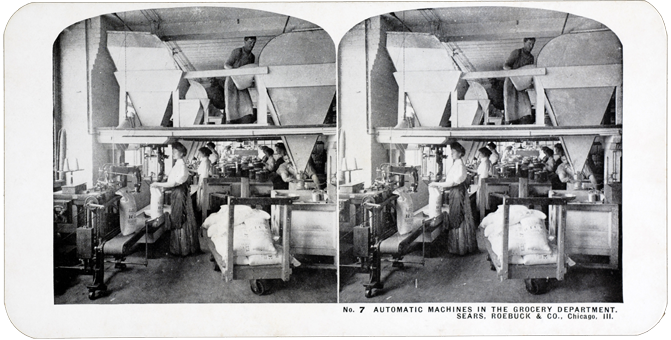
No. 8. WATCHMAKING IN THE JEWELRY DEPARTMENT.
The story of Sears, Roebuck & Co., is the story of a watch, because the nucleus of this great organization was a simple little time-piece which first interested Mr. Sears in merchandising, and finally led him into the mail order business. From the very beginning our jewelry department has been one of the largest in the institution and it has been one of the most popular with our millions of customers. It has been our policy to bring any of the luxuries of life within the reach of those in modest circumstances, and our efforts in this direction have been signally successful in all those lines commonly found in a jewelry store. We have undoubtedly been responsible for a wonderful change in method in the jewelry business, we have compelled manufacturers and dealers generally to modify their selling plans, so that today it is possible for men and women to secure watches and rings and other articles of this character at a lower price than ever before. We have been selling everything in the jewelry line at a reasonable price, a price carrying but a small margin of profit. All those lines of merchandise which represent articles not actually needed by the average individual have always paid large profits to business men selling them, and probably no one line has yielded the profits which have come from the selling of jewelry. We have placed jewelry on the same plane with necessities, offering watches, rings and diamonds, silverware and all these allied lines at the mere cost of material and labor, with the same uniform margin of profit added that we add in departments which sell necessities. This policy has made this the largest jewelry store in the world. The stereoscopic view herewith gives you a view of one comer of this department showing a score or more of watchmakers at work Thousands of our customers who purchase jewelry from us prefer to have us handle their repair work when any is necessary, and as a result we find that we have to maintain a large repair department for their accommodation.
No. 9. MEN’S AND BOYS’ CLOTHING.
One of the great industries within our gigantic institution is our clothing manufacturing plant, with its complete and modem equipment, occupying the entire ninth floor of our huge Merchandise Building. It is flooded with daylight from both windows and skylights, and is the cleanest and most sanitary manufacturing plant in existence, so that our great force of expert draftsmen, cutters, trimmers and tailors work amid the most congenial and healthful surroundings. It is indeed the finest and largest plant of its kind in the world.
To give you some idea of the immense clothing trade that this plant takes care of, we receive from 3,000 to 5,000 requests per day from our customers who desire our various free sample books of men’s ready made clothing, men’s made to order clothing and boys’ clothing. These, together with our large catalogue, bring us clothing orders at the rate of from 4,000 to 6,000 per day. This shows how thoroughly the buying public appreciates the fact that we are quoting manufacturers’ prices on clothing (just about one-half retail prices). We show you a view of part of our cutting department, where we have about 750,000 yards of cloth on hand all the time. We carry constantly a stock of about 50,000 men’s ready made suits, not including overcoats and single pants, and a stock of about 25,000 boys’ suits: This is constantly being sent out , orders from our customers, and being replaced by new stock from our manufacturing plant, so that we ship hundreds of thousands of suits and other garments during the year; and, in addition to this, great quantities of working clothing, fur coats, etc., for which we have a special factory outside of Chicago.
It is this great manufacturing department with its superb equipment and its enormous consumption of woolens made especially for us, which enables us to name such remarkable prices on every grade of clothing for men and boys, really manufacturers’ cost, with but the Smallest margin of profit added.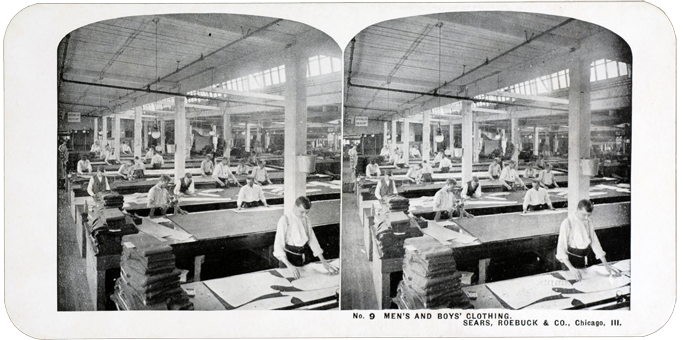
No. 10. A FEW TALKING MACHINE RECORDS.
While most of the pictures in this set of stereoscopic views deal entirely with interesting places here and there throughout the several buildings, we felt that almost all our customers would be interested in this picture in our Talking Machine section which shows a little corner of the Merchandise Building devoted to graphophone records. We are probably the largest dealers in talking machines' and records in the United States. We bought one million graphophone records in one order, and you may know from that how extensive our business in these machines has become. The wonderful success of our Graphophone Department is due entirely to the high grade machines we offer and the wonderfully low prices we make. We have been underselling all other dealers, and know other firms will be unable to compete with us in the future. If you are interested in a talking machine, don’t fail to read about our great offers in our General Catalogue, the fine machines we sell, the wonderful values we give in the very best machines and records at prices never before heard of; and then, remember that these machines and records; go to you at prices so much lower than others ask, that you cannot' afford to buy of any other dealer. Please remember that while we sell graphophones for cash, the saving in price we make f6f you is so large that you can well afford to pay our price in cash rather than to buy the same machine on monthly payments and pay double the price we ask. If you are thinking-, of buying a talking machine, don’t fail to read our offers in our Big General Catalogue, or if you haven’t a copy of the big book, write for our FREE Talking Machine Catalogue and we will send it to you by return mail free and postpaid.
No. 11. PACKING GOODS FOR SHIPMENT.
The picture shown on the other side gives you a view down one side of our freight packing room, and will give you some idea of the army of men engaged in packing merchandise for shipment by freight to our customers. The freight packing room is an extremely large room in the center of the Merchandise Building and is covered with a great glass roof so that perfect light and ventilation are guaranteed the employees of this division. In the center of the room is a great balcony, seen to the right of this picture, where the empty boxes are kept in stock to be passed down to the men below as they need them. As an indication of the great quantity of merchandise which passes through this packing room in the course of twelve months, we would say that we used almost two million wooden boxes of various sizes in this room last year. The picture shown herewith gives you but a glimpse of this room. On the opposite side of the balcony is another row of freight packers; and a visit to this division of the shipping floor would prove to be one of the most interesting in the entire plant. Here the activities of the employees are visible; here all the merchandise to be sent out by freight comes to be handled; the great merchandise chutes bring the merchandise from all the departments on the upper floors to this packing room. These men become very expert, handling the goods rapidly, at a glance determining just the right size box necessary to carry a given order. Aside from packing, the labeling and sorting for shipment is done in this room.
No. 12. MAIL PACKING SECTION OF THE SHIPPING DEPARTMENT.
This picture gives you a view of a small section of the Mail Shipping Room, a view down one aisle showing you the young men busily engaged in wrapping packages to be shipped to our customers by mail. Just to the left of the wrappers you will notice baskets of packages, and in the aisle next to these rows of baskets another force of young mien is at work weighing these packages and putting this required amount of postage stamps on each shipment This is a very large department, though the smallest of the several comprising our shipping room. Indeed our Mail Shipping Department alone is larger than the shipping rooms of most big firms in the city of Chicago. It occupies floors pace of 12,500 square feet, and in the busy season of the year we send through this room in a single day as many as 28,000 separate packages of merchandise to be handled by Uncle Sam’s mail clerks. Certain lines of merchandise are handled much m6re satisfactorily and at a much lower transportation cost by mail than by any other means of transportation. This is particularly true of watches and other jewelry items, items that run into large value and yet are light in weight, and therefore cost but a very little to transport. The very great advantage in mail shipping of extremely valuable merchandise lies in the fact that a mail shipment may be registered for a nominal fee, and it is therefore possible to send a watch valued at $50.00 or $60.00 or a diamond worth several hundred dollars almost anywhere in the United States for 25 cents or less, including registration fee, and safe delivery is thereby guaranteed to our customers.
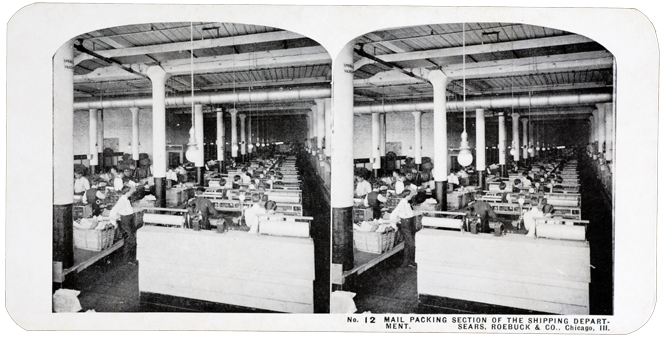
No. 13. THE TRAIN SHED AND SHIPPING ROOMS.
Located around the train shed shown on the other side are the enormous shipping rooms, the mail shipping room occupying about twelve thousand square feet, the express shipping room occupying about twenty-five thousand square feet, and the freight shipping room occupying, about two hundred thousand square feet. All the merchandise, when ready for shipment, comes to one or the other of these rooms, brought thither by automatic conveyers, moving from all sections of the shipping room floor.
It would be very interesting to the customer if, after he has sent us an order for any sort of merchandise, he could then follow it from the time his letter enters our mail receiving room until the goods he has ordered are loaded upon the cars in this train shed and sent on the way to him. After his order has been opened, a ticket.is made out for each department from which he ordered merchandise. These tickets are dispatched by pneumatic tubes leading from the Administration Building to the several departments in the Merchandise Building. Perhaps he orders clothing which is carried in stock on the ninth floor; perhaps he orders a camera, which is to be found on the seventh floor; perhaps he may want a watch from the jewelry section on the fourth floor; a washing machine, which is carried in the basement; these tickets are received in the several departments almost at the same instant, and clerks whom we term “order pickers,” immediately begin filling his order. All merchandise ordered from departments above the second floor is collected in baskets, which are immediately taken to spiral chutes located conveniently to all the departments, and which lead from the top of the building to the shipping room. These spiral chutes are of steel, about eight feet in diameter, containing three spiral planes with doors opening to each one; one for mail shipments, one for express shipments and one for freight shipments. The baskets containing the goods are put in one of these openings and immediately begin a gravity descent to the shipping room. This process is very rapid and goods are disposed of about as rapidly as if they were thrown out of the window. The centrifugal force of the fall through the chute causes friction, however, which regulates the speed of heavy and light baskets in their descent to the shipping room, so that even glassware will go down the entire nine stories without breakage. When the baskets arrive at the bottom of the chutes they slide out on horizontal traveling conveyers or endless belts which run around the four sides of the shipping rooms and this large train shed in the center of the building. The heavier goods, such as washing machines, plumbing articles, furniture, groceries, etc., are carried in stock either in the basement or the first or third floors, and, instead of being conveyed to the shipping room through the spiral chutes, are carried there by means of inclined traveling conveyers. The goods are thereby delivered automatically to the proper shipping room, and under this marvelously simple system the merchandise you order is in the car and on the way to you in an incredibly short time.

No. 14. LONG DISTANCE TELEPHONE SWITCHBOARD.
In addition to our private telephone plant equipped with automatic telephones, we use the service of the Chicago Telephone Company with its long distance connections with New York, Boston, St Louis, Minneapolis, St. Paul, Cleveland, Detroit and all of the great cities East and West, and this stereoscopic view shows you the great switchboard located in the Administration Building. Our customers have very little idea of what it means to carry an enormous stock of merchandise to be prepared to fill orders received from them promptly. Our business has grown so rapidly that many times we have found it difficult to get merchandise in sufficient quantities to fill our orders as promptly as we endeavor to fill all them, and hundreds of times daily we find it necessary to avail ourselves of the Long Distance Telephone in reaching factories and producers all over the East and West. To take care of this service we have twenty trunk lines, employ four operators and have 135 department telephones distributed throughout the institution. Thousands of messages pass over these wires every day and keep these young ladies in the picture extremely busy providing quick and satisfactory service.

No. 15. AUTOMATIC TELEPHONE SWITCHBOARD.
This view of an interior in our great mercantile institution represents what is undoubtedly one of the great inventions of this electrical age. It is located in the basement of the Administration Building and is our automatic telephone switchboard. We have installed automatic telephones throughout our entire establishment for interdepartment communication. We therefore own our own telephone plant as used by department managers and their assistants. The great advantage of this system lies in the fact that the switchboard is purely automatic, no switchboard operators being required. You will notice in the foreground, resting on the bell box, what looks like an ordinary telephone. In the center of this instrument you will observe a dial with notches around the right half; these notches are numbered from one to ten. This dial revolves to the left, and to get a given department, say No. 123, the receiver is taken off the hook, the index finger inserted in notch number one and the dial pulled around to the left until the finger strikes the index just to the left of the lower center of the dial, when the dial is released and permitted to return to its original position; then the finger is inserted in notch number two and the operation repeated; then the finger is inserted in notch number three and the dial turned to the left as before. This has registered in the automatic switchboard the connection for phone No. 123, and when you press a button in the base of the instrument it rings the bell in department 123, just the same as it would be rung by a girl calling from the ordinary switchboard. The great advantage in this style of telephone is that communications pass from one department to another in absolute confidence. It is not possible for anyone else to hear a conversation passing over the wire. We have 325 automatic telephones installed in this plant. In addition to this automatic telephone system we also employ the services of the Chicago Telephone Co. for long distance purposes, as illustrated and explained in another view.
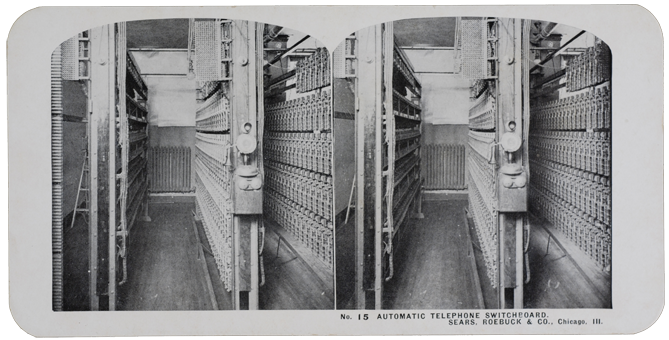
No. 16. PNEUMATIC TUBE STATION.
Probably the most valuable time saver employed by us to facilitate the transaction of business in the new plant is the very elaborate system of pneumatic tubes used for bending written communications, orders, etc., between departments throughout the several buildings. The illustration will give you an idea of this very large system, this picture representing the station in the Administration Building which is said to be the largest of its kind in the world. More than fifteen miles of tubing were used in the installation of this system and it undoubtedly takes, the place of an army of messenger boys-and handles inter-department communications at a tremendous saying in time. Letters and orders received from our customers are opened and read, in the Administration Building and from this central building are routed through this tube station to the proper merchandise or clerical departments for handling, and as this service is operated by compressed air it is almost instantaneous. These tubes carry what we call a cartridge, which is a hollow cylinder about four inches in diameter and about twelve inches long. Letters, orders or papers are inserted in this cartridge and the cartridge in turn dropped into the tube and the great air pressure forces this carrier at a very high rate of speed to its destination. This illustration gives you but a faint idea of this particular station two sides of the room not appearing in the picture. It is not an uncommon thing for the boys in charge of this room to handle more than twenty-seven thousand cartridges in the course of a day’s work, and in the entire tube system more than seventy thousand cartridges or carriers are handled in a single day.

No. 17. THE GREAT TUNNEL.
Beginning at the power plant is a very complete system of underground tunnels, constructed of concrete and extending under all the buildings of the general plant, connecting the various buildings with each other. It is possible by means of these tunnels ta reach every building in our forty-acre plant, and the very large expense entailed by the construction of this system of tunnels was assumed in order to facilitate the prompt movement of merchandise and to afford every possible advantage in the expeditious handling of the vast quantities of mail received and forwarded to the several departments daily. These tunnels are almost % mile in length; they carry the electric conduits, heating pipes, water mains, steam pipes, etc. which are required in the various buildings. Probably the greatest advantage we mid these funnels give us lies in the fact that any one section or building might be destroyed by fire without interfering with our private fire protection system, the two telephone systems and the wires carrying electric current for lighting and power. It is a very simple matter to cut off the water, the heat, the light or the power from any one section by turning the valves or switches connecting the pipes and wires with any given section or building at the point of junction in the tunnel. In a plant so large it is necessary to adopt every means, possible to protect the institution from total destruction, and to insure the transaction of business from day to day without interruption though disaster should overtake a portion of the plant. In addition to using the tunnels for the several conduits necessary Carry electric current, heat and water, we also utilize them in conveying the great quantities of refuse matter, broken packing cases, sweepings, discarded records, correspondence, etc. to the furnace room in the power plant where this refuse matter is converted into heat, light and power. All the tunnels are large enough for the average individual to pass through them walking erect. It may interest you to know that these tunnels and their connections carry about 100 miles of pipe for heating purposes, 4,400 miles of copper wire for carrying electric current, and ten miles of sheet metal pipe for carrying heated air in the winter time and filtered cool air in the summer time.

No. 18. ON THE STREET AT NOON.
From 11:20 until 2:00 o’clock the entrance, to the Administration Building is a very popular spot with all our employees. The main dining room, is located in the basement to the right in this picture, and its entrance is through the Administration Building. Here employees in the several departments meet friends who are separated during the hours of labor; here Department Managers meet and join in a stroll through the gardens across the way, and it seems to be a sort of common ground where all meet on an equality and enjoy a brief visit with each other during the recess at the noon hour. The photographer who took this picture evidently set up his camera upon an exceedingly warm July or August day as the forest of umbrellas and parasols attests.
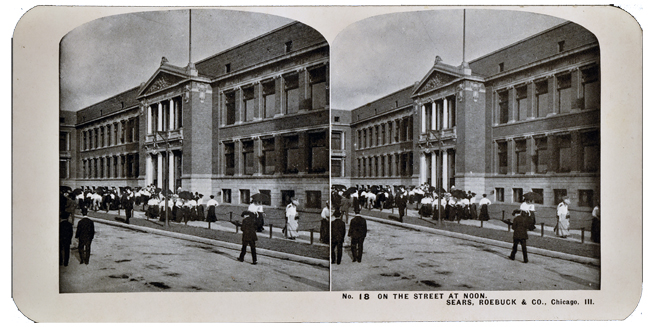
No. 19. A GLIMPSE OF THE ADMINISTRATION BUILDING.

No. 20. THE ADMINISTRATION BUILDING FROM THE PERGOLA.
The illustration herewith gives you a view of the magnificent entrance to the Administration Building, the home of the executive officers of Sears, Roebuck & Co. This entrance is one of the most beautiful architectural triumphs and has been illustrated and described in the greatest architectural journals in the country. This picture was taken from the Pergola just back of the Sunken Garden, a popular retreat for our employees, and one of the most unique and decorative structures Chicago. The quiet scene spread before you here is in striking contrast to the scenes of activity within the Administration Building. To the right of the entrance and on the second floor, is the great Mail Opening and Mail Auditing Departments where our customers orders are read and the cash received credited. To the left is the Correspondence Division which handles more, than 7,000 letters to our customers every working day; while on the first floor are the Auditing and the Banking Departments. This view, and others in this series, must convey to you some idea of the splendid working conditions which prevail in and about this great mercantile house. Indeed our plant is located in an ideal spot where the air is pure, and there is plenty of sunshine; and since we have beautified our grounds as shown in this illustration and others in this series of views, the surroundings of those who work for us are unusually attractive. We believe these surroundings inspire our workers to better things and make for contentment and happiness.
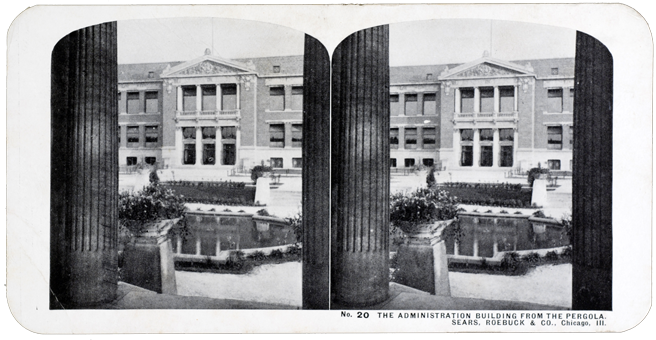
No. 21. LOBBY OF THE ADMINISTRATION BUILDING.
Visitors to the great plant of Sears, Roebuck & Co. invariably comment on the great beauty, of the several buildings their striking architecture; and undoubtedly our Administration Building is one of the most perfect examples of modem architecture of our time. Its most striking exterior feature is the general entrance on Harvard Street shown in another view. The picture on this card is a view-pf the lobby just after passing through the door of the great entrance and it is a most beautiful lobby. The floors are marble, the wainscoting is marble, and it is lighted by great Windows of plate glass during the daytime, and by great clusters of electric lights showing through opalescent glass in the ceiling at night. The stairway in the picture leads up to the main floor occupied by the Executive Offices and some of the major clerical departments; while to the left and right of this main stairway, marble steps lead to the basement in which is located the main dining room. In quiet elegance we doubt whether this lobby is excelled in any building in the City of Chicago.

No. 22. MAIL OPENING AND MAIL AUDITING DEPARTMENTS.
If there is any one department in this establishment more interesting than another to the vast majority of our visitors, it is that department which receives our daily mail. As practically every order comes to us by mail, and our business has now grown to such an enormous volume, the mail received by us each day is of unusual proportions and it requires one hundred and twenty people to open and read the first class mail which comes to us each working day in the year. It is no uncommon experience for us to receive ninety thousand letters and postals in a single day.
The government sends our mail by special wagon four times daily, and as rapidly as the mail sacks are received in the Mail Opening Department the letters and postals are passed through a machine which stamps the date and hour of arrival in the house on each and every piece, this work being performed automatically at the rate of eight hundred per minute. The postals are then separated from the letters and the edges of the envelopes opened by machinery. An expert operator on the mail opening machine will handle from ten thousand to twelve thousand letters per hour. The opened letters are passed to careful clerks who remove the contents from the envelopes and separate those letters containing orders from those relative to miscellaneous matters.
In the Mail Auditing Department the orders sent us by our customers are read carefully to see that they are regular in every respect; that the catalogue numbers, sizes, and all other necessary information has been given by the customer, so that we may intelligently handle his order.
After the orders have been carefully scrutinized they are delivered to what we call the Cash Crediting Division. Here the cash creditors verify all moneys and papers received and ascertain whether remittances are in regular form. Sometimes money orders are incomplete, a check may be unsigned and any number of defects are discovered every day in remittances received from customers, which make it impossible for us to collect funds sent us by them, and the principal labor of the Cash Crediting Division is to see that all remittances are good before the order is accepted. The amount of money included with an order is then indicated on the face of the original order and a record made. The orders are then passed to another division where a second record of the order is written, this being our permanent record of the transaction, which indicates the invoice number, the state in which the customer lives and the amount of money received. After this handling in the Mail Auditing Department, the orders are sent to the Entry Department. It may be of interest for us to tell you that we have received in a single day’s mail, customers' orders accompanied by post office money orders, express money orders, checks, drafts and currency to a total of three hundred and fifty-three thousand dollars.

No. 23. MAKING A RECORD OF THE CUSTOMER’S ORDER.
This department is one of the most interesting as well as one of the largest departments, in point of number of employees, in this institution. During the busy season of the year, six hundred young women are employed in this room, the picture showing only a portion of this great office. The average number of young women in this department the year around is approximately five hundred. It is here that every order for merchandise is entered in our records, and the mere statement that from five to six hundred people are constantly employed in entering orders received from bur customers will give you an idea of the great volume of business transacted by us. These young women are far above the average in intelligence, the very nature of their work requiring that they should be well educated, that the orders from our customers may be intelligently handled. Upon the accuracy of this department the merchandise managers must depend in filling orders.
The work of this great department is divided into eight divisions, to conform to the system designed to facilitate the handling of customers’ orders. The Entry Division writes all the orders for the merchandise departments. These order tickets average in excess of sixty thousand daily. In the busy season of the year one hundred and five thousand tickets a day are handled in this room. The work of transcribing customers' orders to merchandise order tickets is performed on special typewriters; four hundred of these typewriters being in use at the present time. This gives the order fillers in the Merchandise Building typewritten instructions, thus minimizing the possibility of error and facilitating the filling of orders.
It would be almost impossible to imagine a busier place than this department. Every young woman is intent upon the work in hand. The roar of four hundred typewriters, hurrying messengers delivering new orders and collecting finished orders, the intense application of every employee in this department conveys to our visitors a most adequate idea of the immense volume of business transacted in this great merchandising institution every twenty-four hours, and while the number of people engaged exclusively in the writing of customers’ orders is enormous, the activities of all employees in this department are directed along systematic lines, so that the work moves with precision and wonderful rapidity. Of the thousands and thousands of orders which come to this department every day, every one is copied and delivered to a merchandise department the same day it is received by us.

No. 24. THE ROUTING DEPARTMENT.
Every order which comes to Sears, Roebuck & Co., passes through the hands of men and women employed in this large room. This is what we call bur Routing Department, where the orders are routed by the routing experts who indicate to the Shipping Department the shortest, fastest and cheapest route possible, that the customer may receive his merchandise within the shortest possible time and at the lowest possible transportation expense.
All bills of lading, all address labels for mail and express packages and freight crates and boxes of all the different kinds are written here and all the vast clerical detail of our shipping system so handled that it is absolutely certain that all orders, except those containing goods which must be made to order, will be filled in the merchandise departments, loaded on the cars in the shipping room and on their way to destination within forty-eight hours after the order has been received by us.
When the orders have been handled in the various divisions of the Routing Department they are then dispatched by means of the pneumatic tube system to the several merchandise departments in the Merchandise Building. As each of these tubes will deliver twenty carriers per minute and there are dozens of these tubes, you will understand with what rapidity these facilities enable us to handle this enormous volume of clerical work when we say that the orders dispatched require us to handle in this room as many as 105,000 shipping tickets in a single day of nine hours. The young men and young women employed in this department must be of a high order of intelligence, extremely accurate in their handling of orders to insure the safe and certain delivery of the articles needed by our customers and ordered by them from the pages of our big General Catalogue and the innumerable special catalogues and sample books issued by us.
From the standpoint of the customer this is one of the most important departments in the house, as it is here that the decision of our employees determines all such matters as will control the handling of his order by the transportation companies.
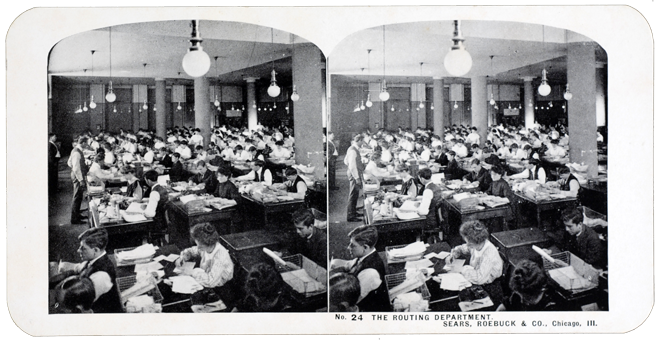
No. 25. WRITING LETTERS TO CUSTOMERS.
The General Correspondence Department handles practically all inquiries from the customer and any correspondence-that may be necessary on shipments made directly from our Chicago house, including letters regarding delay or damage in transportation, etc. This department handles about seven thousand inquiries and; letters of all kinds every working day.
If the customer finds that some article has been omitted from his shipment or damaged by the transportation company in handling, the Correspondence Department inspects the records in the case and takes the necessary action to give the customer whatever adjustment may be due him.
In the Adjustment Inspection Department, which is an annex to the General Correspondence Department and is located in another room not shown in the picture, all of these adjustments are carefully inspected to see that both the house and the customer are treated fairly.
The volume of mail handled throughout Sears, Roebuck & Co’s, great mercantile institution in the course of a day is simply enormous; and s6me idea of the number of people required to handle this correspondence with our customers may be obtained from this picture which illustrates just one of several departments handling letters from our customers. We have a lively appreciation of the fact that every customer’s idea of us is obtained almost entirely from the letters received from us, and it is therefore our endeavor to secure the services of high class men and women that our policies of dealing with the greatest liberality with our customers and in a spirit of fairness in every case may be properly carried out.

No. 26. STENOGRAPHIC DEPARTMENT.
In this room between one hundred and fifty and two hundred young women are engaged in transcribing- letters dictated by correspondents throughout the institution. This dictation is received in the Stenographic Department by two methods, each of which requires specially trained operators. By one method the typist goes directly to the correspondent and takes his dictation in shorthand, returning to this department where she transcribes the letters just received. By the other method the correspondents dictate their letters to a graphophone. The cylinders are then sent by messenger to the graphophone division of the Stenographic Department, where each operator has a graphophone and typewriter, and quickly transcribes the dictation.
Over ten thousand letters are written in this department each day, and as these are handled upon schedule time, no letter can remain in the department longer than two hours. A large force of collectors, distributers and mail dispatchers is required, and the system is so perfect that not a paper may be mislaid or lost. An interesting feature of this department is the record which is kept of the work of each individual operator. The lines in every letter are counted and the operator is given credit therefor, while the department for which it was written is charged. Any mistakes that are made are charged against the responsible party, and the records thus obtained are extremely valuable in determining the standard of the personnel of the department.
Another interesting fact is the quantity of stationery used. On an average ten thousand letter heads and twenty thousand second sheets used in making carbon copies for our records are consumed in this department daily, while, the actual value of all the office supplies is of such large proportions as to be almost unbelievable. This is one of the busiest departments of the institution and to enter into a detailed description of its various activities would require a small volume.
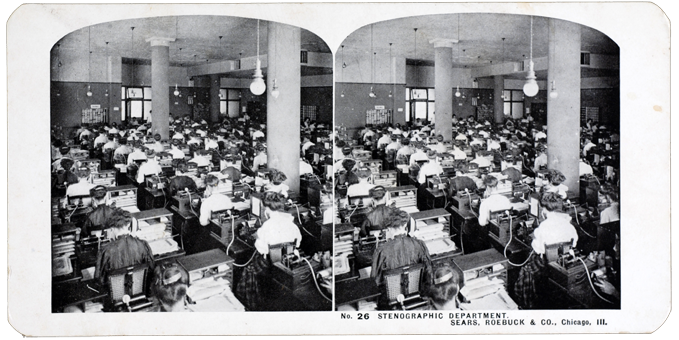
No. 27. THE CARD INDEX DEPARTMENT.
This large room, filled with filing cabinets, is our Index Department, where we keep a record of all our transactions with our customers. One hundred and fifty-three employees are required to keep these records and this room contains the names of more than six million customers and a full and complete record of every transaction with each of them. When an order is received from a customer, an index card is prepared from that order in the department where all orders are entered, and this index card comes to, this Index Department, where it is sorted in the sorting division according to state and town, then passed to young women in charge of the index cabinets devoted to that particular state or part of a state and filed alphabetically according to state and town. This elaborate method of keeping our records, while seemingly complex, is indeed very simple and enables us to immediately obtain the full record with reference to any single transaction with any customer anywhere in the United States. If a customer sends us a letter with reference to a shipment we can immediately refer to the record, providing he gives us the post office that the goods were ordered from or the shipping point to which the goods were shipped, should it be different from his post office, and we quickly as certain the exact amount of cash received by us and the merchandise ordered by him, so that the correspondent may obtain all the records in the transaction and handle the matter to the satisfaction of our customer. From these index cards we also obtain the names of those to whom we wish to send special advertising matter. To keep this index up to date, a division is devoted to correcting the cards of our customers who notify us of any change in their post office addresses. Our records include all post offices, all shipping points, R. F. D. numbers, sub-stations, summer post offices and discontinued post offices, and we dare say that the government itself has no more complete record of all these matters than exists in this Index Department, The character of our business is such that we are dependent upon system in handling it, and in this department centers the complex systematizing necessary to the preservation of our valuable and indispensable records.
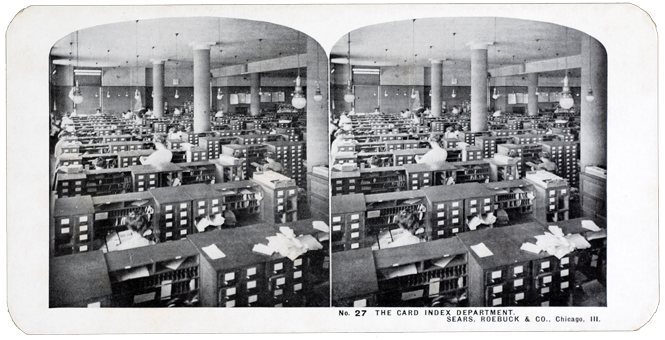
No. 28. COUNTING THE MONEY RECEIVED DAILY.
The young ladies shown in this picture are employees of the accounting division of the cashier’s office. The Cashier’s Department is one of the), busiest departments in the house. All our patronage comes to us by mail in cash or its equivalent, and every penny of our great volume of business must be accounted for in the Cashier’s Department. We handle an average of 25,000 Post Office Money Orders, 3,300 Express Money Orders, and 5,000 checks, in addition to thousands of dollars in currency which our customers send us in registered mail, every day in this department. It is here that the money is .sorted, the checks, money orders and drafts listed and prepared for deposit in the several institutions which handle our banking deposits; and in this particular division shown in this view eighteen adding machines are in constant use preparing this work for the banks. In addition to handling cash received from our customers, the cashier’s office makes all allowances to customers when it is necessary to return the customer’s money because of our inability to fill his order if the goods are out of stock or have been damaged in transit, or for any other reason have failed to reach him. It also handles the pay roll for more than 9,000 employees, and it keeps the accounts of the Employees Savings Bank, conducted iii the interest of the employees, paying 5 per cent interest compounded quarterly on all sums left on deposit by workers in the institution. The cashier’s office also handles the finances of the Seroco Mutual Benefit Association, deducting the monthly dues from each member’s salary from month to month. It would be very difficult indeed to itemize the many different accounts handled, in the cashier’s office, but in an institution employing 9,000 people and handling between $50,000,000.00 and $60,000,000.00 business in the course of a year, there are hundreds of employees who find their time fully occupied every hour of the day.
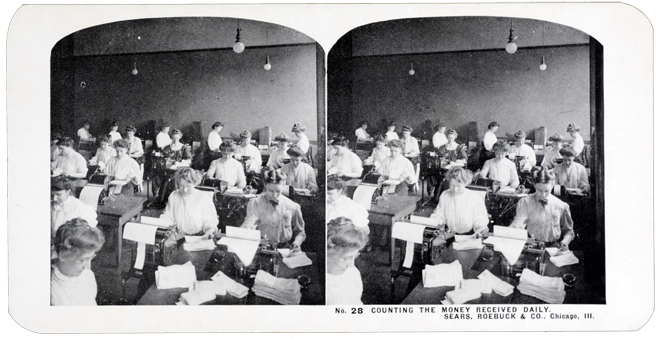
No. 29. THE CLOSING HOUR.
It is indeed an inspiring sight to witness the departure of the great army of men and women employed in this merchandise institution at the close of, the day’s work. At half past five the streams of humanity pour out of the several buildings, and the sidewalks, street cars and elevated trains are soon congested with a jolly mass k of homeward bound humanity. All the street car lines and the elevated railway companies make special provision for handling the more than 9,000 people who work here day in and day out. During the rush hours in the morning, special cars and special trains are run to the plant; and in the rush hours of the evening, special cars and special trains are awaiting this great concourse of people. The picture, shown herewith gives you but a glimpse East on Harvard Street in front of the Administration and the Printing Buildings. Less than 40 per cent of our people find their employment in the Administration and Printing Buildings, so that this picture does not give you an adequate idea of the great crowds of people to be found on the streets at closing tune. You ought to stand m the Pergola in the Sunken Garden to get a full view of the number of people employed here. No camera’s Jens could possibly catch the full scope of this scene of life and animation between 5:30 and 6:00 p. m.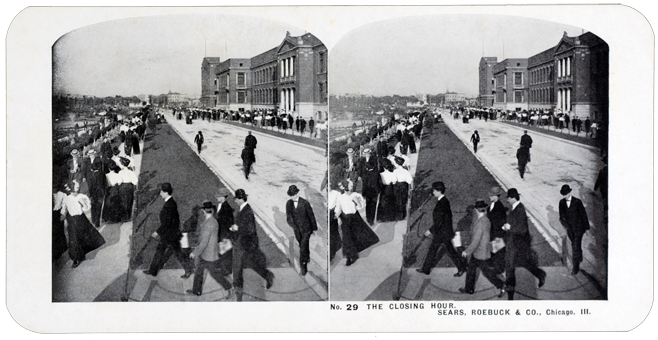
No. 31. TYPE SETTING AND TYPE MAKING.
The printing industry has passed through a wonderful evolution within the past twenty years. The methods in use today in the manufacture of all sorts of printed matter are radically different from those employed even ten years ago. The hand compositor, the man who set type ever since printing was invented, has to a large extent given way to automatic machines which do this work much more rapidly and more satisfactorily than it can be done by hand. The Linotype Machine, which sets type in solid lines, and the various type casting machines for making single type, all find their uses in a printing plant like ours. One of the best of the type making machines is shown in actual operation on the other side of this card.
Nothing can be more fascinating than the operation of these automatic machines; they display almost human intelligence and the observer can readily believe that their gradual evolution from the first ideas of fifty years ago has cost millions of dollars in money and the undivided energies of hundreds of ingenious inventors. It is only by making use of every aid, such as these wonderful type setting and type casting machines, that we are enabled to produce such a tremendous work as our 1200-page catalogue twice a year, containing the latest novelties up to the very day of publication.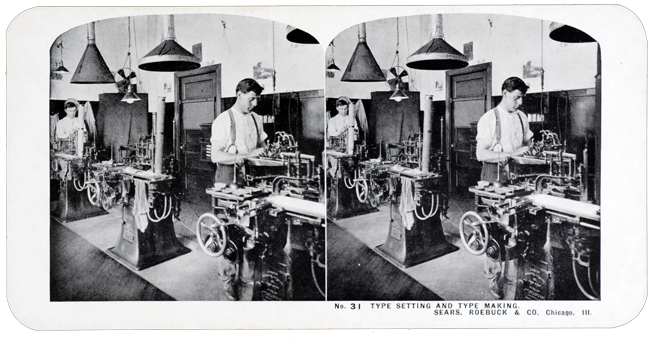
No. 32. THE ELECTROTYPE FOUNDRY.
None of our catalogues, the big general book nor any of the specials are printed direct from the type; all are printed from electroplates, and this is the manufacturing department which produces them. After the type has been set and the managers have read the text carefully and approved it, the page of type and illustrations is sent to this department where it is molded in wax. This wax mold is hung in a bath of chemicals charged with a current of electricity and a very thin film of copper is deposited over the face of the mold. This film of copper is then placed in a casting box where molten metal is poured over it and then trimmed and planed just type high, completing the electrotyping operation. The hard copper face of the electrotype plate gives it great wear resisting properties and it is in this particular that it is more desirable for printing purposes than type itself. No rotary printing press such as we use will print from type, so that electrotypes are necessary. After the electrotype has been finished in the manner outlined above, it is run through a bending machine which gives it a semi-circular form, and the electrotype so bent is then fastened to the revolving cylinder of the rotary press. This process has made possible the wonderful advancement in the printing art and the production of the highest class magazines at a mere fraction of their cost twenty-five years ago.
N° 33. Où est imprimé le Gros Catalogue.
Cette vue prise du centre de l'aile de notre salle des presses du "Printing Building" est juste un aperçu de la plus grande salle d'impression privée du monde.
Chacune de ces grosses rotatives reçoit le papier en rouleau et imprime, plie et délivre 5000 sections de 32 pages de notre "Big Catalogue" par heure. Ces énormes machines automatiques, les plus modernes dans leur genre, fonctionnent à l'électricité, et nos visiteurs trouvent ce département le plus intéressant de tous nos établissements. Dans le courant de l'année nous envoyons à ces presses un ruban de papier de 46 pouces (~117 cm) de large suffisamment long pour faire 9,8 fois le tour de la Terre. Si ces rouleaux étaient empilés les uns sur les autres, nous aurions une colonne de papier blanc haute de 30 miles (~48 270 m) et de 31 pouces de diamètre (~ 79 cm). Comme ce papier est fait de pulpe de bois, les moulins qui le produisent pour nous, consomment, chaque jour ouvré de l'année, la production de 6 acres (~ 24 000 mètres carrés) de forêt. Il faut comprendre que ces chiffres représentent seulement le papier utilisé pour notre "Big Catalogue", et qu'en plus de ça, nous consommons des milliers et des milliers de tonnes de papiers spéciaux pour nos catalogues spéciaux, les bureaux et la papeterie. Nous avons installé les machines les plus modernes de toute sorte, depuis les presses jusqu'à la reliure, et notre organisation est si précise, et la capacité de notre "Printing Department" est si gigantesque que nous somme capables de produire en un seul jour 30 000 copies de notre catalogue de 1200 pages. Nous envoyons plus de 6 millions de ces gros livres par an, et assurant nous même le fonctionnement de cet énorme usine, c'est une autre raison nous permettant d'afficher des prix aussi bas.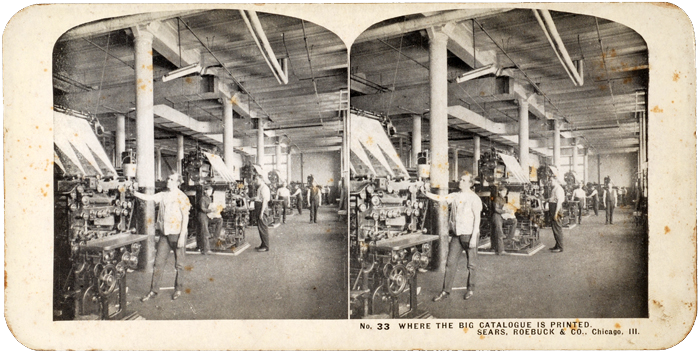
No. 34. A CORNER IN THE PRESS ROOM.
Another very interesting corner of this great printing establishment is that devoted to the job printing presses, a manufacturing division where we print the millions of blank forms used in the numerous clerical and merchandise departments of our house. There are nine small presses used for printing small quantities of stationery and office blanks, and seven automatic presses which produce enormous quantities of office blanks in one or two colors of ink. These automatic machines are marvels of mechanical ingenuity, each press being self-feeding and running at a rate of speed which produces from five to seven thousand printed sheets per hour. If Gutenberg, the inventor of printing, could come back to earth today and glance into a modem printing establishment, he would scarcely recognize the craft he followed in his lifetime. Even Benjamin Franklin, one of earliest printers in America, would see little in common between the printing press of his day and the great complicated machine of today which converts a roll of white paper into thousands of printed and folded pages every sixty minutes. Probably rib industry of our time has made more rapid strides than the printing industry and it is even now undergoing great and important changes. The invention of typesetting machines and rotary printing presses has cheapened the production of newspapers, periodicals and books and has placed the finest literature of the ages within the reach of those in the most moderate circumstances. In the production of Our catalogues we have taken advantage of every improvement, every up to date facility and believe we operate the finest printing plant in America, manufacturing a larger quantity of printed matter than is used in the- business of any other commercial institution of today, and if the present rate of increase in the demand for our catalogue is maintained this year, this great printing department must be further enlarged.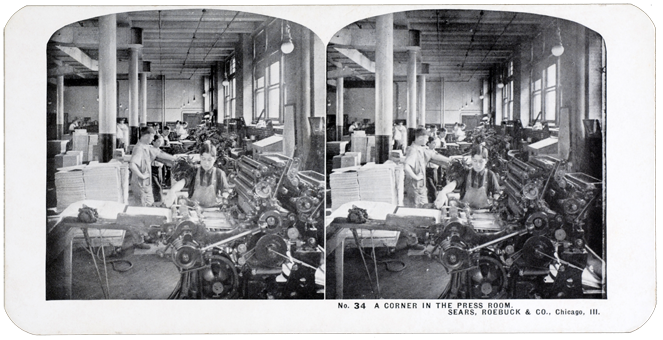
No. 35. AUTOMATIC GATHERING MACHINE.
The great printing presses on the first floor of the Printing Building, print and fold the pages of our Big Catalogue in sections of 32 pages each. To make the complete book requires 38 of these 32-page sections, and these several sections of the book must be gathered together either by hand or machinery. The picture on the other side of this card shows you the Automatic Gathering Machine which gathers these different sections, piling them one on top of the other in their proper sequence and delivering the book ready for the Covering Machine. It is difficult to describe the mechanical operations of this machine - one of the marvelous inventions used in the printing industry. The 32-page sections are piled in boxes around both sides of this machine and with every turn oi the wheel, a mechanical finger pulls one of these 32-page sections from the bottom of the pile and drops it upon a moving carrier beneath; as the finger returns to pull another section from the bottom of the pile,-this carrier moves to another box to receive an entirely different section, and by the time each carrier has moved from box No. 1 to box No. 38 it has received the 38 different sections and the book is complete. The mechanical fingers of this machine are operated by compressed air and are adjust6d with marvelous accuracy. If, for instance, a page should be missing from a 32-page section, this finger instantly detects the defect and stops the machine and displays a signal indicating where the trouble lies. On the other hand, if it should accidently get two sections between its fingers instead of one, it would immediately indicate the fault by stopping the machine and displaying the signal. In other words, this machine is so nicely adjusted that it automatically discovers any missing pages or excess of pages; thereby preventing imperfect copies of the book passing to the Automatic Covering Machine. This machine guarantees better results therefore than were obtained by the old method of gathering by hand. This is the largest Gathering Machine in existence and was built especially to our order. 
No. 36. ONE OF OUR AUTOMATIC COVERING MACHINES.
A number of the processes followed by us in the manufacture of the big General Catalogue are explained on other stereoscopic views in this series, the composing room, the electrotype foundry pressroom, etc., being very fully described, on other views. This picture represents an Automatic Book Covering Machine which completes the binding of our big 1200-page catalogue. After the several sections of the book have been gathered in our Automatic Gathering Machine or by hand, these loose sections come to this or one of the other two Automatic Covering Machines, and the young lady in the foreground drops the loose sections of the complete book into this machined It is instantly clasped in a vise-like grip and the back or folded edges of all the loose sections automatically trimmed on with a heavy knife at one operation. The smooth back then runs over a dampening wheel then over a wheel carrying a thin coating of glue; after which a third wheel gives it a heavy coating of glue; just after the completion of this operation the machine automatically picks up a strip of binding cotton and presses it against the glued back of the catalogue. It is this strip of binding cotton which gives the catalogue a flexible back. After receiving this strip of cotton, a cover is pressed against the back, the glue oozes through the porous cotton back, and as the book continues to travel around this machine as shown in the illustration, this cover is folded and pressed against the back until the book has reached its starting point, when the clamp is automatically released and the binding is complete. Three operators can produce about 8,000 books per day with this machine.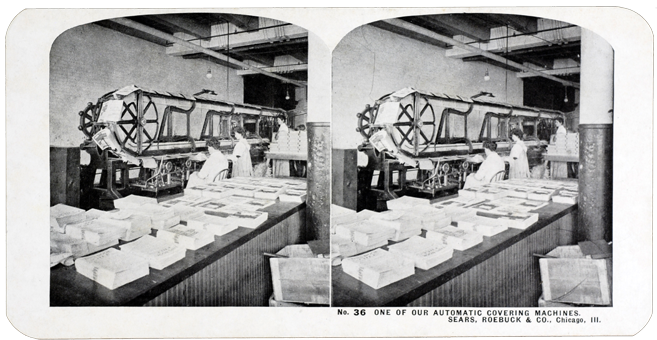
No. 37. CATALOGUE TRIMMING MACHINE.
Every modern machine and appliance known to the bookmaking industry is employed in the printing plant to facilitate the rapid and the economical production of our Great Catalogue. In another view we show you the main aisle of the great press room, and in other views we show you additional machinery used in manufacturing our catalogue, all of which machinery is employed in our printing processes to bring the book up to the stage in manufacturing which makes the use of the machine shown in this illustration necessary. This is one of our two machines known as Continuous Catalogue Trimmers. After the paper has passed through the presses and the sections have been gathered together and bound in the Automatic Covering Machines, the top and bottom and the right hand edges of the book are in a rough, unfinished condition. The book is then fed into one of the great machines shown in the picture on the other side of this card, and great knives trim the unfinished edges and make the catalogue ready for mailing. This machine has a capacity of 20,000 of our 1200-page catalogues per day.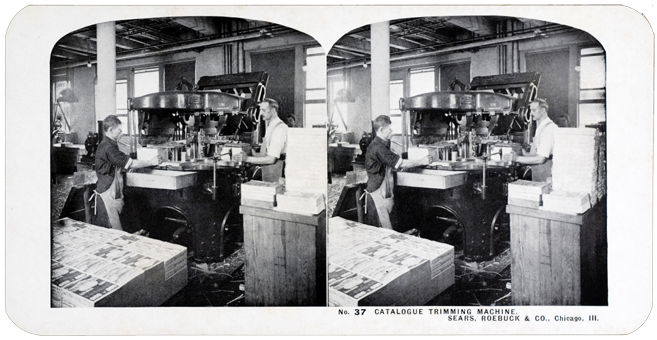
No. 38. THE BOILER ROOM IN THE POWER PLANT
The boiler room is one of the most interesting features of our power plant, and the boilers have an ultimate capacity of 12,000-horse power. These boilers are of the very latest improved high pressure type, designed especially for us and equipped with automatic chain grates and smokeless furnaces, so constructed -that the waste paper and refuse from the Various buildings may be used in the creation ’of heat and light and power for the premises. The coal supply is unloaded from >the cars on the track beside the building and carried by automatic machinery to an overhead coal bunker having a capacity of fifteen hundred tons of coal, from which it falls through chutes to the boilers below, as required. The coal carrying machinery in the boiler room has a capacity of one hundred tons per hour. The refuse and ashes are automatically conveyed to an ash bunker and deposited in the cars ready to be taken away. All these facilities have lessened the amount of hand labor usual in plants of this character; and the workmen employed in the boiler room are able to maintain the steam pressure without the arduous toil so common to most furnace rooms.
One of the unique features of this power plant is the towering chimney which furnishes the requisite draft for the boilers. This chimney is constructed of radial brick; it is 250 feet high, 14 feet in diameter, and is supported on concrete caisson foundations 60 feet in depth, the height from bedrock to crown being 310 feet. The weight of this smoke stack is 2,500 tons.
No. 39. THE MAGNIFICENT ENGINE ROOM IN THE POWER HOUSE.
The enormous amount of power, heat and light required in this group of buildings for the usual and special purposes made it necessary for us to construct one of the most gigantic power houses of its kind in the world. It occupies a central position in the group of buildings, and covers thirty thousand square feet of space. The building is absolutely fireproof, constructed of steel, concrete and brick, and was especially designed to receive the special apparatus and machinery required. All of the generating apparatus, boilers, engines, etc., are located on the first floor, while the connecting pipes and automatic apparatus are located in the basement. The engine room is extremely ornamental, finished throughout with white enameled brick with red English tile floor, with a magnificent visitors’ gallery from which all the machinery may be conveniently viewed.
The entire power plant is designed and laid out to permit of the greatest economy in its mechanical operation. There are installed Corliss compound condensing engines directly connected with their respective electric current generators. Within this power house are innumerable air compressors, house and elevator pumps, fire pumps, artificial ice making plant, heaters and other varied and special machinery supplying all the power, heating and lighting necessities of the general buildings. In this room is developed an electrical current sufficient to maintain eighty thousand incandescent lamps, and six thousand arc lamps, an electric current which would light three hundred towns of fifteen hundred population each. The power developed operates two hundred and twenty-five electric motors, forty elevators, thirty pumps, and compressed air apparatus operating fifteen miles of pneumatic tubes. The engine room is equipped with an especially designed crane capable of handling the heaviest piece of apparatus m the plant with readiness and dispatch. All the heavy machines installed were handled by this crane, which has a lifting capacity of twenty-five tons. A crane is considered one of the most necessary appliances in a large power house, and without this one we would have been sadly handicapped in the work of installation. In fact, we would have been unable to accomplish the work we aid in so short a time without the use of this valuable and very essential machine.

No. 40. THE GREAT SWITCHBOARD IN THE ENGINE ROOM.
The enormous electric power developed in the engine room, an ultimate capacity of 12000-horse power having been provided for, is controlled by one of the largest electric switchboards ever constructed, specially designed for this plant and carrying all the necessary instruments and appliances to insure reliable service in every portion of the buildings day and night. A picture of this switchboard is given in this stereoscopic view. Not only is this one of the largest switchboards ever constructed} but in the matter of special features, special apparatus designed to serve a special purpose, this switchboard is undoubtedly unique. The plant is equipped with a supervisory signal system which indicates on the switchboard at any time of night or day the condition of all the fire protection appliances and the other special services furnished throughout the numerous buildings. The engineer standing before this switchboard finds it an index to conditions prevailing at any given spot in the plant and enables him to furnish a service which guarantees the best results for all concerned. The wonderful advancement made in electrical science in recent years is well exemplified in this marvelous switchboard which carries the very latest and most scientific apparatus, insuring the comfort and safety of the thousands of people employed by us.
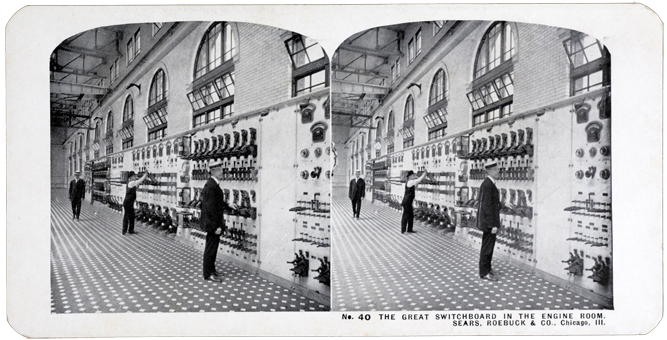
No. 41, MAIN DINING ROOM SEROCO RESTAURANT.
Not the least of the problems which confronted the management when it was decided to build the new plant in a residence district in the City of Chicago was that of providing meals for the nine thousand employees. It was manifestly impossible for them to find restaurants near the new plant either large enough or in sufficient number to supply their wants, and provision has been made in both the Administration and Merchandise Buildings for a complete restaurant equipment serving meals morning, noon and night, Our restaurants are five in number and together they comprise what is probably the largest restaurant in the world. It is certainly the largest in the City of Chicago and provides food for more people at one time than any other restaurant in existence. It is taxed to its utmost capacity at noon, and to facilitate the handling of the great number of people requiring service, employees are dismissed in relays, and under this plan it is possible for us to feed eight thousand four hundred in one hour and twenty minutes. We can take care of more than two thousand at a time and we have provided meals for twelve thousand five hundred in one day. It requires one hundred employees to provide this restaurant service.
It is a matter of pride that the most careful inspection of our restaurants and their equipment by the health authorities of the City of Chicago has brought from them the statement that these are the cleanest and best restaurants which have come under their notice in this city. Every appliance, every convenience known to modem methods in the preparation of food is in use in this restaurant.

No. 42. THE GIRLS' CAFETERIA.
We have, in addition to the main dining room, a lunch counter, where a quick light lunch may be secured in a very few minutes. Adjoining the lunch counter is the men’s cafeteria. The service here is on the “help yourself’’ plan. The women’s cafeteria, shown on the other side of this card, adjoins the men’s on the north, and the service is distinctly the same as that in the men’s cafeteria. In the Merchandise Building a big section of the basement is given over to a cafeteria provided for the accommodation of the employees in that building. The service in this cafeteria is identical with that in the two previously described, both as to bills of fare and prices. The foods are carefully selected and well prepared, notwithstanding the fact that the prices are so extremely moderate. It is possible to secure a meal for 9 cents in either of the three cafeterias, this meal comprising two sandwiches, a cup of coffee or a glass of milk, a piece of pie, some cheese and fruit. It is possible for an employee to live at our restaurants, and live comfortably, though of course on plain food, for 35 cents per day.
We have another cafeteria where those who carry their own lunches may eat them at the noon hour. The use of silver and napkins in this cafeteria is free.
It is not the purpose of the management to operate the restaurants at a profit, but rather to afford the employees of the house opportunity to secure wholesome and well cooked food at cost and to serve the meals in comfortable quarters. We endeavor to give every consideration to comfort, prompt service and economy, and as time, goes on and conditions improve, we hope to be able to give our employees still better service than that now furnished them.
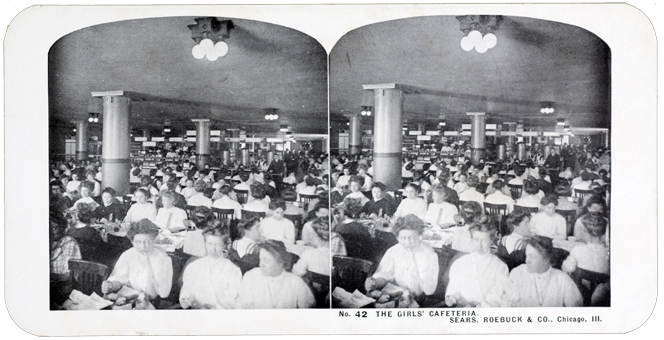
No. 43. THE KITCHEN, SEROCO RESTAURANT.
As we are compelled to prepare as many as 12,500 meals in a single day in our several restaurants the facilities in our kitchen must necessarily be proportionately extensive. The view on the other side of this card is a glance along one side of our kitchen. Numerous ranges, broilers and cookers are provided; the dishes are washed by automatic machinery; and every equipment which will make for better service is employed in this great department. We employ a chef of wide experience to direct the preparation of all the dishes served in our several dining rooms and under him are employed a large number of skillful cooks, all of them specialists in their-lines. Some devote their entire attention to roasts; others to the preparation of vegetables; still others to the making of pies and cakes; and It would do the average housewife good to peep into this great kitchen with its magnificent equipment of everything that is newest and best in kitchen furniture and appliances. The woman who prepares three meals a day for a family of from five to seven finds her time fully occupied every day in the year, and she can understand what a tremendous, labor it must be to prepare to serve 12,500 meals within twelve hours. She can imagine how many people will be required to prepare the potatoes for instance; how many would be engaged at certain seasons of the year in shelling green peas; how many would be removing the husks from green com; she can imagine, also, the size of the steam cookers and kettles which are required to cook these vegetables after they have been prepared; she can imagine the capacity of the roasting ovens; and undoubtedly she would find this department of our great restaurants—the largest restaurants in the City of Chicago—the most interesting corner of this great forty acre merchandising institution.
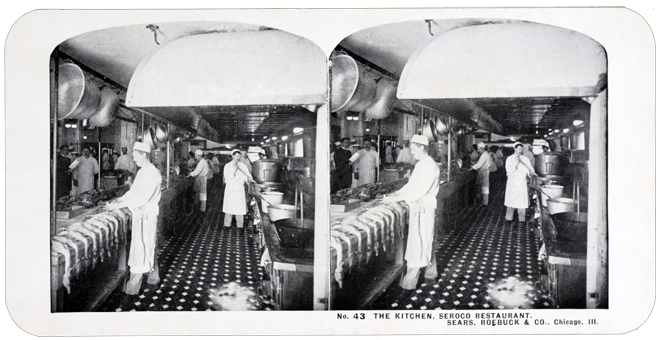
No. 44. THE GREAT REFRIGERATOR IN THE RESTAURANT.
As an adjunct to our kitchen the great refrigerator as shown in the illustration on the other side is a most interesting feature. Here great quantities of perishable food stuffs are carried in stock, and as we have fed as many as 12,500 people in a single day, the need for refrigerators of enormous capacity is apparent. This picture gives you but a glimpse of a portion of the refrigerator and you will notice that there is a very large supply of meats, milk, eggs, poultry, watermelons, etc., in stock in this section of the refrigerator. We buy our meats in enormous quantities and age them in our own refrigerator. We have an artificial ice plant and consume in this refrigerator and in the dining room service more than a ton of ice per day. All the water we use on the premises for cooking, drinking and ice making is from our own artesian well and is filtered before using.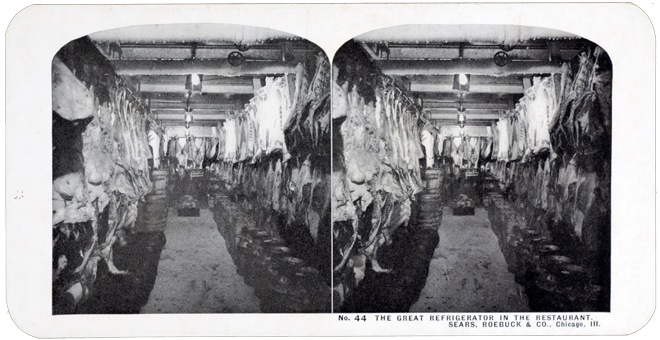
No. 45. SUNKEN GARDEN AND PERGOLA.
In securing a site for our New Plant we purchased forty acres of ground in one of the most populous residence sections of the City of Chicago, where over nine, thousand employees now spend their working hours each day in an atmosphere unpolluted by the factory smoke and odors common to the manufacturing and business sections of a great city. Located in the center of; a district of homes, we felt that our great buildings should be architecturally pleasing, and our grounds should be so laid out as to prove an attractive resting place for our employees and our neighbors during the hours in the day when they were not engaged in business affairs. In deciding upon the purchase of this large tract we had in mind the future expansion of the business and the probability that other and larger buildings would be required at same time in the future; but in the meantime, we have devoted large sums to landscape, gardening, in an effort to beautify the space not as yet occupied for business purposes. The illustration will give you an idea of the great beauty of the sunken garden across the street from the Administration Building. It has been laid out in the form of a great rectangle, and almost every variety of ornamental shrub; and tree and flower has been used to make it beautiful. In the center of the garden is an artificial lake, and great fountains play all day long in the sunlight. Back of the garden a Grecian pergola has been constructed of cement, and this classic structure, covered with creeping vines, will become a veritable bower, where tired employees may spend a little time at the noon hour in the open air. We believe it good business to beautify our grounds in this manner, that our employees may be attracted out of doors during the noon recess, because a change of environment and attractive surroundings send them back to work again greatly refreshed and forgetful of the little annoyances of the morning.

No. 46. THE FOUNTAINS AND GARDEN.
This is a view of the Fountains and Sunken Garden with a portion of the Administration Building and Printing Building in the distance as seen from the Pergola just back of the Sunken Garden. The Gardens which extend for a whole block just across the street from the Administration Building maker this one of the most beautiful spots in the whole City of Chicago. An artificial lake has been constructed in which three great fountains play in the sunlight from morning until night. Between the lake and the Pergola are several other fountains and on a hot summer’s day the Pergola is a favorite spot with our thousands of; employees, because the fountains cool the atmosphere and add not a little to the pleasure of a stroll through the gardens. Besides the thousands of flowers in the flower beds, great ums here and there filled with blooming plants and vines, add to the beauty of this spot, and the winding paths are thronged- with tired employees who find this breathing spot in the great City a delightful place to forget the little trials and troubles of the morning.
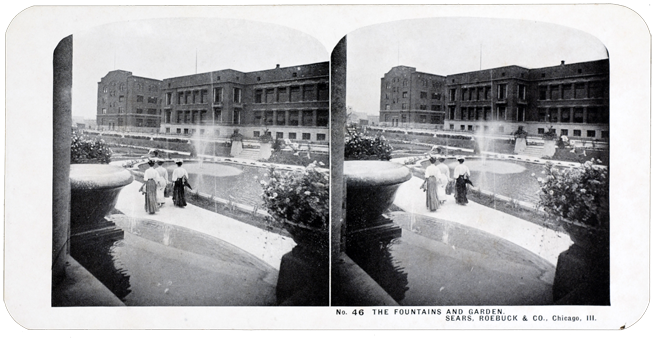
No. 47. THE GREEK PERGOLA.
The most striking feature of the great garden, a block in length, just across Harvard Street from the Administration Building, is the Grecian Pergola shown in this illustration. It is a very large structure, much larger than the picture would lead you to believe. Its great columns are made entirely of cement, and the roof on either end is built of red tile. Our gardens have been planted but a little more than a year, so that the shrubbery, trees and vines are young and have not as yet' made the showing they will within the next two or three years. Various varieties of climbing vines have been planted around this open structure, and soon these vines with great clusters of bloom will cover the columns and roof, and it will be a veritable bower of beauty. Its classic outlines add the finishing touch to our beautiful gardens, than which there is nothing more attractive in the City of Chicago.
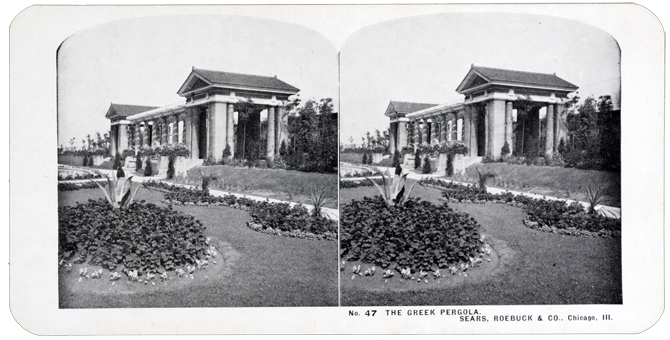
No. 48. THE TRAINING SCHOOL.
In an institution employing 9,000 persons there is naturally a continuous shifting of employees which necessitates employment of new people. It is essential that these new people be given careful training in the house system before they are allowed to handle the customers’ orders. For the purpose of giving such training systematically and thoroughly, the Training School has been established. New employees spend from three days to three weeks in the school, according to the importance of the work for which they are being trained. They acquire here a general knowledge of how the customer’s order is handled from the time the Mail Opening Department opens the letter until the Shipping Room sends out the goods, and this leads them to appreciate more clearly the importance of performing rapidly and accurately their particular part in the filling of the order.
The school rooms are pleasantly located in the Tower. There are four rooms, and in them a corps of eight teachers, not including minor assistants, devote their time to instructing the beginners, correcting their sample work and grading them. The efficiency shown in the school rooms determines the position a new employee is capable of filling. Persons whose careless work indicates a disregard of the interests of Sears, Roebuck & Co.’s customers are not retained in the employ of the house. Fortunately, however, this seldom happens, as a comprehension of the magnitude of the business and the splendid, machine-like system with which it is handled inspires the new employee with respect and loyalty, and an earnest desire to become an efficient part of the great whole.
The picture here shown was taken in the stenographic division of the school. The salaries of stenographers and typists are adjusted before employment by means of a test in speed and accuracy given by the stenographic teacher. After employment they receive instruction in writing special house letters. Graphophone operators also are trained to take dictation direct from graphophone cylinders (the correspondents of the house dictate chiefly on to graphophone cylinders), and bill clerks learn to operate the billing machines. The stenographic room is not a school of shorthand, etc., in the sense in which a business college is; stenographers and typists must have received training and show a certain degree of efficiency before they can be employed.

No. 49. FIRE DEPARTMENT DRILL.
Although we are protected by the city fire department as is every business institution in the City of Chicago, our plant is so extensive,, it covers such a wide territory and there are so many acres of floor space in the several buildings comprising the institution that we have installed special fire fighting apparatus; with an independent water supply of our own. We maintain a fire department under the direction of one of the ablest fire chiefs in the west and in every department certain employees are members of volunteer fire companies and are given daily drills, so that in, case of emergency they will understand just what to do and how to do it. In the great power plant three high pressure pumps are under steam day and night and maintain the required volume of water in the reservoirs and tanks in the tower, and the requisite pressure on all our private water mains. Each of these pumps is Capable of discharging One thousand gallons of water per minute and repeated fire drills, called unexpectedly from day to day, show that we have among our volunteer fire companies exceptionally capable fire fighters, and that in any emergency we could depend upon them to do all that it is possible to do in fighting fire. Supplementing the regular fire fighting apparatus, and as a special protection, particularly against small local fires, we have installed an elaborate system of sprinklers- water pipes running through the Ceilings of all the buildings with sprinkler heads every few feet. These sprinkler heads work automatically. If fire should break out in any section of the Merchandise Building, for instance, these sprinkler heads would open and a heavy rainfall would result, sufficient in a great many cases to entirely extinguish the fire. There are 60,000 of these sprinkler heads throughout the plant. The picture on the other side of this card was taken when one of the volunteer companies was drilling in answer to a call to the Administration Building. The hose cart was taken from its place, connection made and the hose carried up the fire escape to the third story window in 46 seconds. Because of the completeness of our fire fighting apparatus and the excellence of our fire fighting crews we enjoy the lowest insurance rate accorded any mercantile institution.
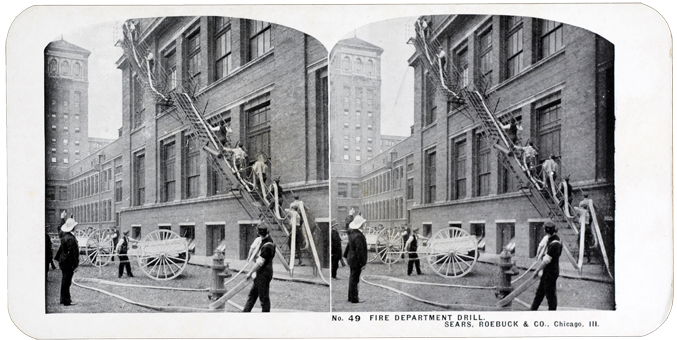
No. 50. A CORNER IN THE EMPLOYES’ HOSPITAL.
In a large business enterprise employing thousands of people, there is an ever present demand for the services of physicians and nurses, and in addition to the normal demand for the services of these professional people, there is a more pressing need for them now and then in an institution which combines manufacturing with merchandising as we do. We have a great many automatic machines; we operate a great many elevators and conveyors; there are hundreds of electric motors throughout the plant; sewing machines, cutting machines, weighing machines and a vast variety of special apparatus requiring the attention of individuals. Under these conditions it is not surprising that in addition to sudden illness among employees we have accidents now and then, and in this stereoscopic view we show a portion of the Employees Hospital in the tower of the Merchandise Building. We have in our employ two physicians and several trained nurses. The laboratory is very complete, and we nave the very latest surgical apparatus and every appliance known to the best hospitals for the handling of emergency cases. We have been particularly fortunate so far since we opened this great merchandising plant in that we have had very few serious accidents, but as we hope to do our part at all times to make our employees comfortable and happy, we have found it good business to keep constantly at hand, men and women who can help those who are taken ill on our premises or who may for any other reason need the services of a physician or nurse during business hours. In addition to maintaining this hospital, there is an organization of employees known as the Seroco Mutual Benefit Association maintained by monthly dues in amounts regulated by the size of the employee's salary, and this association pays benefits to sick members who, by reason of illness, may be kept from their employment.








